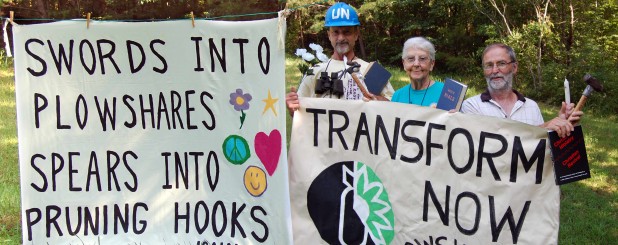KEEPING SCORE » U.S.
Life in The National Security State
February 6, 2014 · 1 Comments

Above: Michael Walli, Sister Megan Rice and Greg Boertje-Obed.
By Murray Polner:
The news that Sister Megan Rice, an 84-year old nun and two army veterans, Michael Walli, 65, and Greg Boertje-Obed, 58, are about to receive prison sentences for challenging, no, for daring to protest America’s long love affair with nuclear weapons has drawn little or no media interest. They are scheduled to be sentenced on February 18th.
So what was their crime? Cutting a hole in a barbed wire fence in one of Oak Ridge’s ultra-secret National Security sites on July 28, 2012, and then crossing over into prohibited ground, hammering on the Highly Enriched Uranium Material Facility and spray painting some “Biblical graffiti,” leaving behind Isaiah’s subversive aphorism about beating swords into plowshares.
You would think that the break-in at the highly secretive, presumably well-protected Y-12 National Security Complex at the Oak Ridge, Tennessee, nuclear facility, their subsequent federal trial in Knoxville, why they did it yet failed to convince the jury, let alone the American public, would merit some serious attention from the Newspaper of Record, the handful of remaining inquisitive American newspapers, or network TV’s evening “news.” But no one was murdered or even wounded by a hail of bullets from vigilant guards. No one was captured and beaten. No one resisted arrest. The trio did what they did, and surrendered, willing and eager to explain.
The Times’ William J. Broad did have a substantial piece, “The Nun Who Broke Into the Nuclear Sanctum” about Sister Megan Rice but that was back on August 12, 2012, after the break-in. The last time I’m aware of any interest on their part was October 31, 2012, when an article discussed the failure of the site’s security, where incredibly, no-one at the facility shouted, “Halt, who goes there?” at the trespassers. Since then, silence.
In any event, the trio was tried and found guilty in federal court in Knoxville and fined $52,053--which the government will obviously never collect since in all probability a nun, a house painter, and an unemployed activist do not usually generate much financial gain from a personal portfolio of stocks and bonds. What they accomplished wasn’t much, just shutting down some Oak Ridge activities for two weeks. But they also reminded the guardians of the nuclear site that apparently anyone—even people bent on doing real damage—could just saunter in and possibly do as they pleased. So here’s another question for the Times and others: What are we paying those private security companies for?
It’s as if the Berrigan brothers suddenly returned for a second act. It was Phil’s quixotic brainstorm, which he called the Plowshares movement and which rejected our endless, unaccountable government-sponsored violence. Some one hundred men and women during the eighties and nineties hammered on and spray-painted MX missiles, Trident submarines, B-52 bombers and components of the strategic nuclear triad, sending some to prison.
Phil Berrigan once spoke about how hard it was to get fellow Americans interested in what they were saying. “Even sympathizers thought Plowshares actions look ridiculous now, a sermon to the converted, ignored by the government and the media, the public no longer listening.” Of course he was right. All the same, he and his friends left a gift to anti-nuke radicals like Sister Megan Rice, Michael Walli and Greg Boertje-Obed who would never lose their faith, however naive it may sound to most, in the power and majesty of nonviolence, much like that old revolutionary, Isaiah.
Back to Oak Ridge. If obsolete cameras and barbed wire fences could not keep three older people out of the Y-12 National Security Complex, should any independent investigative journalists still left in the Obama Era of Espionage Act Violations not ask why all those pricey weapons? Against whom are they supposed to be used? At the trial, the prosecuting U.S. attorney told the jury that nuclear deterrence was vital for our defense but no-one outside of that Knoxville courtroom seemed very interested in asking why.
But what if we have a nuclear accident, or just another Petrov Incident? Remember that? When Soviet Lt. Col. Stanislav Petrov in 1983 saw a missile heading for Moscow on his radar screen and soon after, four more U.S. missiles approaching, he didn’t report it because he was smart enough to suspect a computer glitch. Had he done so and his bosses retaliated with their nukes, most of us would no longer be among the living. There have been other near-misses, some reported, some not. You’ll need an FOI request to find out. Given frightened and confused reactions in our Nuclear Age, anything can happen.
During the trial, the judge said he hadn’t found the defendants "contrite." Kathy Boylan, a longtime peace worker, testified in their behalf, even alluding to the Holocaust. She quoted Dorothy Day, co-founder of the Catholic Worker, peace and nonviolence activist, opponent of conscription, all wars and a faithful Catholic who may yet wind up beatified by the Church, saying, “If we wouldn’t put people in gas chambers, why would we fling gas chambers at them?”
“Michael,” Boylan told the court, referring to Walli, “is trying to save lives. Your life,” she told the Judge, and then turning toward the prosecutor, “Your life. All our lives.”
Anyone at the Times interested?
Murray Polner writes our “Keeping Score” column and wrote, with Jim O’Grady, “Disarmed and Dangerous,” a dual biography of Daniel and Philip Berrigan.
By admin
Readers Comments (1)
Sorry, comments are closed on this post.










Simply profound.
Thank you.
-Jim